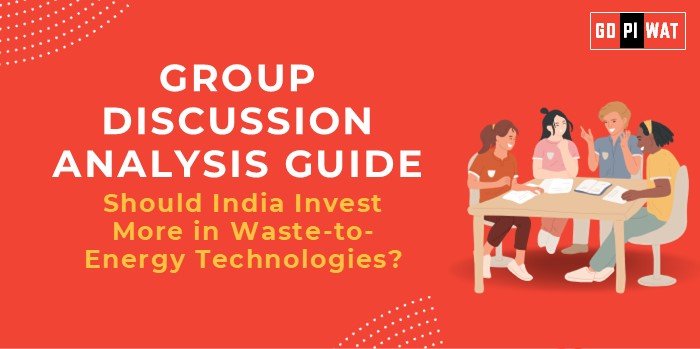📋 Group Discussion Analysis Guide
♻️ Should India Invest More in Waste-to-Energy Technologies?
🌟 Introduction to the Topic
Context Setting:
“With urbanization and industrialization, India generates over 62 million tonnes of municipal solid waste annually, of which only 22-28% is treated effectively. Waste-to-energy (WTE) technologies offer a sustainable solution to manage this growing waste challenge while addressing energy deficits.”
Background:
Waste-to-energy technologies convert non-recyclable waste materials into usable forms of energy. While globally adopted, India’s WTE adoption is limited to a few operational plants, reflecting both potential and challenges.
📊 Quick Facts and Key Statistics
- 🗑️ Municipal Waste Generation: 62 million tonnes annually; projected to double by 2030.
- 🌍 Untreated Waste: 70% ends up in landfills, leading to pollution and land degradation.
- ⚡ Current WTE Capacity: ~400 MW from 92 plants, contributing <1% of India’s energy needs.
- 🇸🇪 Global Leader: Sweden converts 99% of its waste into energy or recycled materials.
- 🔋 Energy Potential: India’s waste could generate up to 5 GW of power annually.
🤝 Stakeholders and Their Roles
- 🏛️ Government: Policy formulation, subsidies, and infrastructure investment.
- 🏭 Private Sector: Plant development, operation, and technological innovation.
- 👨👩👧👦 Citizens: Waste segregation at source to improve feedstock quality.
- 🌍 NGOs and Environmental Groups: Advocacy for sustainable waste management practices.
🏆 Achievements and Challenges
Achievements:
- 🏗️ Operational Plants: Delhi’s Okhla plant processes 2,000 tonnes of waste daily, generating 16 MW.
- 📜 Policy Support: Swachh Bharat Mission includes WTE as a key component of waste management.
Challenges:
- 💸 High Costs: Initial setup costs are prohibitive for many municipalities.
- 🗑️ Feedstock Quality: Mixed waste reduces efficiency and increases emissions.
- 🌫️ Public Resistance: Concerns over air pollution from WTE plants.
- 🌎 Comparative Global Examples: Sweden’s success contrasts with India’s challenges due to better waste segregation and stricter emission norms.
🗣️ Structured Arguments for Discussion
- ✅ Supporting Stance: “Investing in WTE can address India’s waste and energy crises simultaneously, promoting a circular economy.”
- ❌ Opposing Stance: “High costs, technological limitations, and environmental concerns make WTE less viable than recycling or composting.”
- ⚖️ Balanced Perspective: “WTE has potential but requires strategic implementation alongside improved segregation and strict emissions control.”
💡 Effective Discussion Approaches
Opening Strategies:
- 📊 Data-Driven: “With 70% of urban waste ending up untreated, WTE could transform India’s waste management system.”
- 🌍 Contrasting Examples: “Sweden’s 99% waste conversion rate highlights the missed opportunities in India.”
Counter-Argument Handling:
- ✔️ Address cost concerns by highlighting potential job creation and long-term savings.
- 🌱 Counter pollution claims by showcasing modern WTE technologies with minimal emissions.
🧠 Strategic Analysis of Strengths and Weaknesses
SWOT Analysis:
- ✔️ Strengths: Renewable energy generation, reduction in landfill dependency, creation of green jobs.
- ❌ Weaknesses: High operational costs, limited public awareness about waste segregation.
- 🌟 Opportunities: Integration with smart city initiatives, international technology partnerships.
- ⚠️ Threats: Regulatory hurdles, public resistance due to environmental concerns.
📚 Connecting with B-School Applications
Real-World Applications:
- 🌱 Studying WTE can inspire projects in sustainable operations or renewable energy management.
Sample Interview Questions:
- 🧐 “What are the environmental and economic implications of investing in WTE technologies?”
- 🤝 “How can public-private partnerships improve WTE adoption in India?”
Insights for B-School Students:
- 📊 Analyze case studies like Delhi’s WTE plants for operational challenges.
- 🔧 Explore integration of WTE in smart cities for enhanced resource management.


